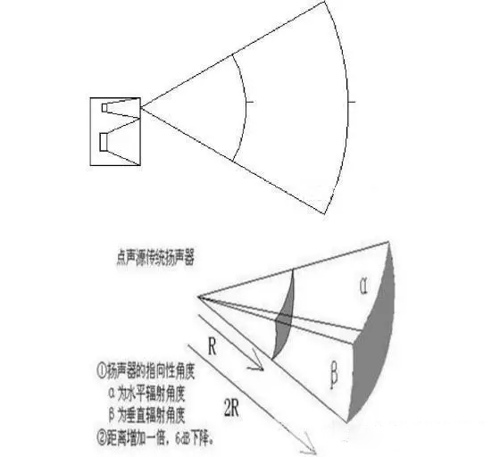The types of sound sources are divided into: point sound source, line sound source, and surface sound source according to their geometric characteristics. In professional audio systems, most of the speakers are designed with point and line sound source shapes. The following are their definitions, principles and formulas.
Point source definition: A sound source that radiates sound waves in the form of a spherical wave. The amplitude of the sound pressure of the radiated sound wave is inversely proportional to the sound wave propagation distance (r). A sound source of any shape can be regarded as a point source as long as the wavelength of the sound wave is much larger than the geometry of the sound source. In the acoustic environment impact assessment, when the distance from the sound source center to the predicted point exceeds 2 times the maximum geometric size of the sound source, the sound source can be approximated as a point sound source.

The point source speaker refers to the diffusion of the point source. It is characterized by a large coverage angle and a fast attenuation of the sound pressure. The distance is usually doubled and the sound pressure level is reduced by 6 dB. In actual application, the sound source speakers can also form an array, but due to the large vertical coverage angle, the interference between the speakers is serious, and the entire sound field cannot be uniformly covered. The array is also attenuated by -6dB, so the sound reinforcement effect is not as good as that of the line array speaker. Common common speakers are mostly point source speakers.
(1) Attenuation values ​​caused by the increase of the point source with the propagation distance:
AdiV=10lg[1/(4Ï€r^2)]
Where: AdiV - the increase in distance produces an attenuation value, dB;
R——the distance from the sound source to the sound point, m;
(2) Attenuation values ​​from the point source r1 to r2:
AdiV=10lg(r1/r2)
The point source sound propagation distance is doubled and the attenuation value is 6 dB.
Line source definition: A line source consists of a series of equal distance drive systems. The use of line sources is based on their very small vertical pointing angle. If its vertical orientation is 0 degrees, this is what we call "cylindrical waves." Whenever the distance of the sound source is doubled, the energy of the cylindrical wave will be attenuated by 3dB. However, if the distance of the sound source is doubled, the energy of the "spherical wave" (point source) will be attenuated by 6dB.

Line array speaker refers to the diffusion of the line sound source. It is characterized by the small vertical angle of the single speaker, which effectively solves the problem of sound interference between the speakers. At the same time, the line array speaker (speaker system) has slow sound pressure attenuation and long transmission distance. Usually the distance is doubled and the sound pressure level is only reduced by 3dB.
Formula for attenuation of line sound source in air
The attenuation value caused by the increase of the line source with the propagation distance is:
AdiV=10lg[1/(2Ï€l)]
Where: AdiV - distance attenuation value, dB;
R——the vertical distance from the line source to the sound point, m;
l - the length of the line source, m.
Our Musical Mug is good in quality and competitive in price. We are manufacturer and supplier of Musical Mug following your specific requirement. We are looking forward to your E-mail and establishing cooperative relationship with you! We would provide professional Musical Mug with good services for you!
Recordable Musical Mug, Recordable Music Mugs for Promotion, Promotional Music Mug
AST Industry Co.,LTD , https://www.astsoundchip.com